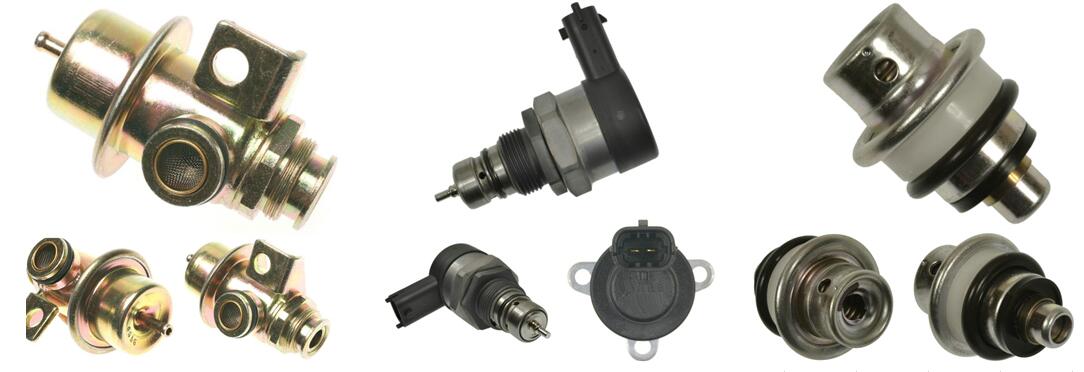
Every vehicle has its fuel system. It supplies a certain amount of clean, well-atomized fuel to the automotive engine. The fuel mixes with a certain amount of air to form a combustible mixture. At the same time, the fuel system needs to store some petrol in case the car has a long way to run.
The fuel system consists of the fuel tank, fuel pump, fuel buffer, fuel pressure regulator, fuel filter, fuel injector, thermostat switch and cold start valve (cold start injector).
● Fuel tank
The fuel tank is for fuel storage.
● Fuel pump
It is to pump fuel from the fuel tank into the fuel pipe. The pump also maintains a certain pressure, which delivers the fuel through the filter to the fuel injector and cold start valve.
According to their installation position, fuel pumps are divided into external and internal pumps. External pumps are installed in the fuel pipeline outside the fuel tank, while internal pumps are installed in the fuel tank.
The external pump is less likely to produce air resistance and fuel leakage and is less noisy. Most EFIs currently use internally mounted pumps.
● Fuel buffer
It is also known as a pulsation damper. The fuel buffer makes the fuel pressure stable. It reduces pumping pressure fluctuations and noise.
● Fuel pressure regulator
The fuel pipe is fitted with the pressure regulator, which keeps the fuel pressure at a certain level relative to the atmospheric pressure or the negative pressure of the inlet pipe.
The difference between the injection pressure and the ambient pressure of the injection is maintained at a certain level.
This pressure difference is generally maintained at 250 kPa. When the supply pressure exceeds the specified value, the pressure-reducing valve in the regulator opens. The petrol flows back to the tank through the return pipe, keeping the fuel pressure delivered constant.
● Fuel filter
It is installed between the fuel buffer and the injector in the fuel pipe. It filters out the water, impurities and other things in the fuel to prevent blocking the injector gauge valve.
● Fuel injector
The injector is installed at the air population of the throttle body (SPI system) or near the intake manifold to the intake valves of each cylinder (MPI system). It is controlled by the injection signal from the electronic controller.
The amount of fuel injected is determined by the length of time the injector is energized. As a result, the right amount of fuel is sprayed into the intake manifold as a mist.
The working principle of the injector is that the controller sends the injection current signal. The current flows through the electromagnetic coil to produce electromagnetic suction.
The suction attracts the core. As the needle valve is integrated with the core system, the valve opens, and the fuel is injected.
● Thermostat switch and cold start valve
It monitors the temperature of the cooling water. When the engine starts and the cooling water is not warm enough, the switch contacts close, causing the cold start valve to inject oil.
The cold start valve injects extra fuel into the intake manifold when cold starting. It improves the starting performance. Many cars have eliminated the thermostat timing switch, and the cold start injectors are fully controlled by the ECU for greater control accuracy.
● Fuel pump
The fuel pump of the EFI engine is driven by an electric motor, so it is also called an electric fuel pump. It is an integrated body of an electric motor and a fuel pump, which is installed in the fuel tank. There are two common types of electric petrol pumps: roller and vane types.
● Fuel rail
This component delivers fuel to the injectors of each cylinder in an even, equal pressure manner. Due to the large volume, it has the function of storing fuel and pressure. It also slows down the fuel pressure pulsation.
● Injector
It injects a certain amount of fuel into the air inlet or intake pipe at the right time according to the instructions of the electronic control unit. The fuel mixes with the air therein to form a combustible mixture.
The electronic control unit controls the injectors. It outputs control current in the form of electrical pulses to the injectors.
The injector is turned on when the electric pulse rises from zero due to energization. When the electric pulse falls back to zero, the injector is turned off due to power failure. The electrical pulse duration from rising to falling is called the pulse width.
If the pulse width of the electronic control unit output is not enough, the duration of oil injection is short, and the amount of oil injection is small.
If the pulse width of the electronic control unit output is enough, the oil injection duration is long, and the amount of fuel injected is enough. The available injector needle valve lift is about 0.1 mm, while the injection duration is in the range of 2 to 10 ms.
● Fuel pressure regulator
The regulator makes the difference between the pressure of the fuel system and the pressure of the intake pipe constant. This is because the amount of fuel injected depends on the duration of the injection, but it is also related to the injection pressure.

The higher the injection pressure, the more fuel is injected within the same injection duration, and vice versa. Therefore, the injection volume under various loads depends only uniquely on the injection duration or electrical pulse width if the injection pressure is kept constant. It achieves precise control of the injection volume by the electronic control unit.
● Fuel buffer
When the fuel pump works, the injector and return plane valve of the oil pressure regulator open and close, which causes the rising fuel pressure in the fuel pipe and pulsation noise. The fuel pressure pulsation is too big for the fuel pressure regulator to work properly.
The fuel buffer reduces the pulsation and noise in the fuel pipe. It also maintains a certain pressure after the engine has stopped to facilitate the engine restart.
● Thermostat switch and cold start valve
The cold start valve injects a certain amount of additional fuel into the intake pipe to enrich the mixture when the engine starts at a low temperature.
The cold start valve is also a solenoid valve. The duration of continuous oil injection depends on the engine temperature. It is controlled by a hot time switch. This component is mounted on the air inlet pipe, and the hot time switch is mounted on the body. It contacts with the coolant.
After a period of use, the water impurities in the fuel will make the oil path not smooth or blocked. Carbon deposits and gum generated in combustion will also attach to the intake and exhaust valves, intake and exhaust channels, throttle and combustion chamber, especially in the gasoline injection nozzle.
As a result, those things will block the injection nozzle needle valve and valve hole, affecting the performance of the precision parts in the injection system, resulting in poor injection, poor atomization, and even no oil injection.
Furthermore, carbon deposits can lead to poorly closed intake valves, which reduces the cylinder pressure and even leads to engine misfire. The unstable engine idling, increased fuel consumption and deteriorating exhaust emissions are troubles we don't want to meet.

Carbon deposits on the piston top and cylinder head are easy to make the combustion chamber too hot, thus, cause engine knocking, increased fuel consumption, engine power decline, unstable idle speed, poor acceleration and starting problems. These failures will shorten the engine's service life.
● Moisture in petrol corrodes and damages fuel system components
If components in the fuel system are corroded and damaged by moisture over a long period of time, there will be problems. The replacement is inevitable. The entire fuel system must be cleaned to remove the moisture from the fuel in order to let the engine run normally again.
● Fuel pipe is clogged with gum and carbon
In winter, if the fuel system is not cleaned in time, the gum and carbon deposits in the pipe will become dirty and blocked, causing poor fuel flow, reduced fuel pressure and blocked fuel filter.
● Engine don't start
Fuel has some water in it. Some water is generated during the refining process, and some is caused by external factors. At normal temperatures, fuel can dissolve some water.
However, the water becomes correspondingly less soluble at lower temperatures, and excess dissolved amounts of water collect.

The specific gravity of water is greater than that of oil. It will slowly separate and stay in the bend of the fuel pipe or the filter, causing a discontinuity in the fuel supply.
When the temperature is lower than the water's freezing point, the water will coalesce and freeze, causing the fuel to become blocked, and making the engine unable to start.
 Lauritz Carolsfeld
Lauritz Carolsfeld  December 30, 2021
December 30, 2021


